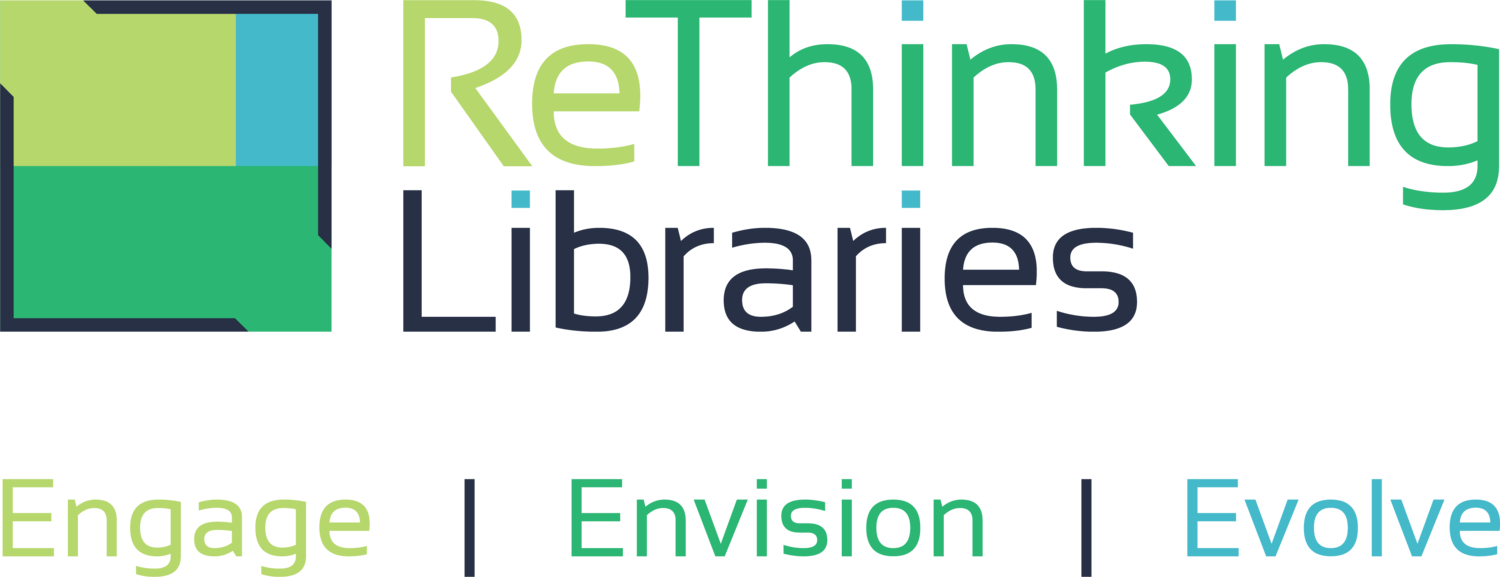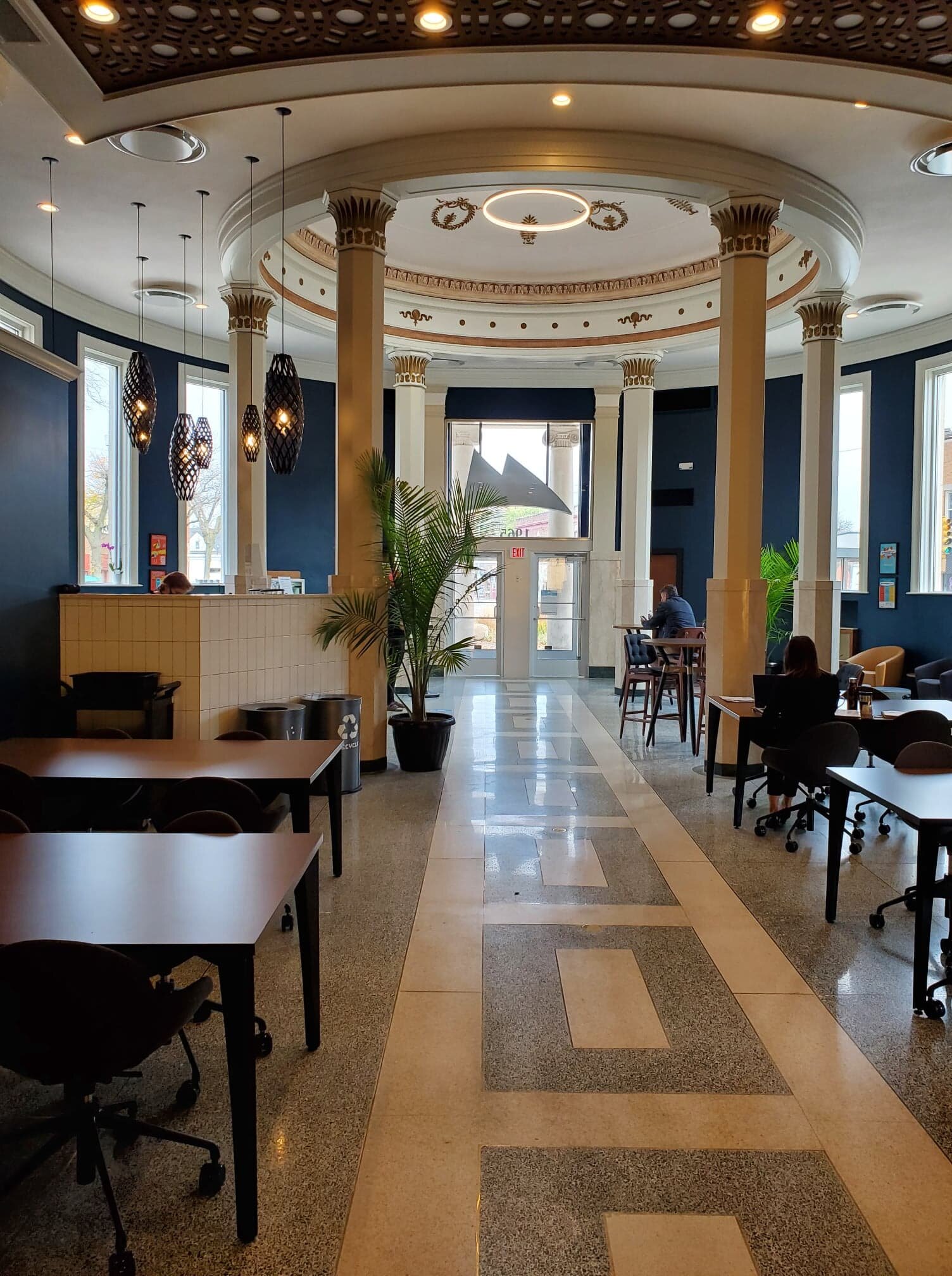Rethinking Community Places: Envisioning New Library Spaces
Café counter and inviting seating greet visitors.
Recently I met a friend for coffee which is a rare occurrence with the ongoing pandemic. I had no idea what to expect when she said, “Let’s meet at The Rotunda”, but I’m always up for a something new. What I found was a beautifully renovated space that sold coffee and pastries but was so much more.
Over time, Monona Bank realized that their customers had changed their habits and were no longer needing as many onsite banking services as they once did. Instead of letting the space in the lobby at their Schenk’s Corners location go unused, they chose to rethink how they offered services to their community. The solution, in addition to continuing to offer banking services, was to create a venue that also offered a café and co-working space.
An extensive renovation of the rotunda and lobby restored historic details while making way for new opportunities. The entry area has a counter for coffee and other café fare but also includes inviting spaces that encourage visitors to stay a while. High-top café tables with stools and groupings of comfortable lounge seating and side tables facilitate cozy conversations or individual work in a relaxed environment.
Moving further into the lobby there are several large tables with space to spread out or collaborate with others and again, surprisingly comfortable chairs. Small nooks are set aside for individual, quiet work or in some cases, small group collaborations. Several small meeting rooms are perfect for more private conversations and available by appointment. Even the former bank vault has been repurposed into a larger conference room.
Of course, since most of my time is spent thinking about libraries, the space immediately brought two thoughts to mind as to how what I saw pertained to libraries.
First, I couldn’t get over how creative they were in carving out small, private spaces, something that is always sought after in the library. Every nook and cranny is reimagined and utilized to its fullest potential. The small rooms are technology enabled and one is even designed for podcasts. The use of glass walls and sliding barn doors in many of the spaces allows light in, enhances safety, and keeps an open, airy feeling even though most of the rooms are quite small.
The overall space is constrained, but the way it’s laid out encourages more active engagement upon entry and then quieter activity the further that you move into the space. The approach is similar to what we often recommend in libraries as a way to separate more collaborative/social spaces from quiet ones. The variety in the types of spaces and furniture is also well thought out.
Second, it struck me that libraries are always looking for community partners that share their mission and are constantly needing to reimagine how they offer services. I could just as easily see an express branch of a library in place of a coworking space being set up in this lobby. As a library, perhaps it could offer “grab and go” popular materials, access to business databases, collaboration spaces, and reference services geared toward the business community, entrepreneurs, and personal finances, whatever would be appropriate to the clientele frequenting the building.
If a bank building isn’t the appropriate place maybe it’s a community center, a senior living complex, or even a food pantry that extends the opportunity for library services. Increasingly, the community members that we engage with during engagement sessions and surveys are clear that they feel the library should be looking for ways to collaborate in their communities to partner rather than duplicating services. What better way to acquaint people with library services than providing them in a place where they least expect them?
Even if it’s not moving into a different space, maybe it’s time to take a hard look at what services the library offers and what interaction there is with other organizations. It’s likely that budgets will be tighter than ever over the next few years and libraries will be challenged to continue evolving to new models and making difficult choices. Getting creative with others in the community and allowing the library to act as a platform may be a way of leveraging resources to offer more without putting all of the burden on the library.
Libraries are critical community resources and unfortunately, not all constituents are aware of the breadth of services that they offer. Being creative and strategic in seeking community partners and communicating the shared value that they provide are just a few ways that libraries can continue to demonstrate how they serve their communities.
Who knew what a trip to the coffee shop would lead to? Keep engaging your community, envisioning the future, and evolving your library.













